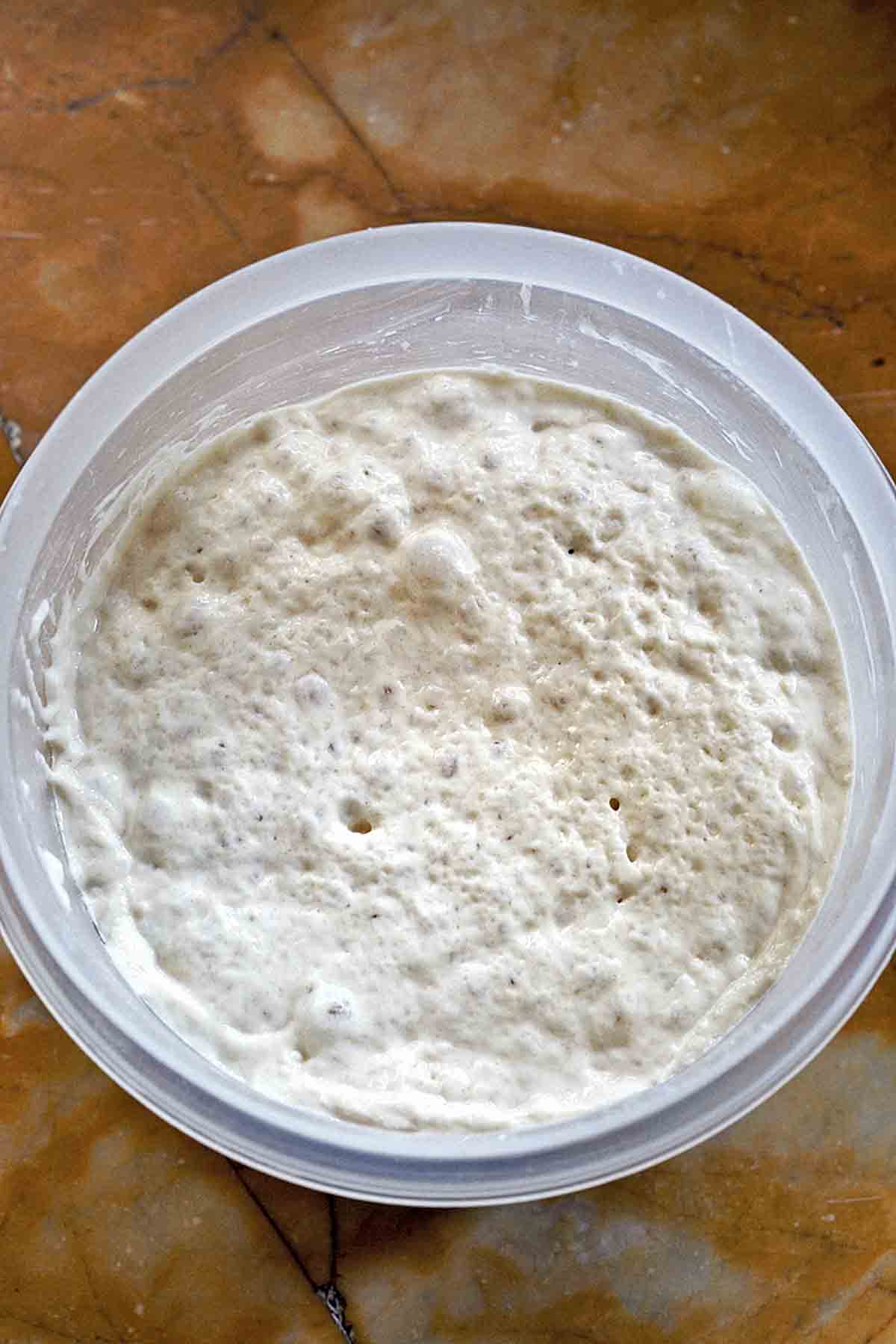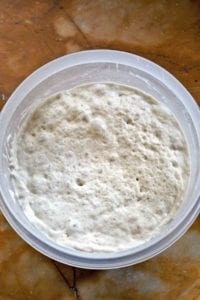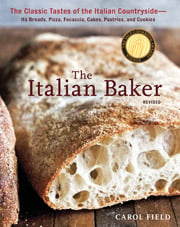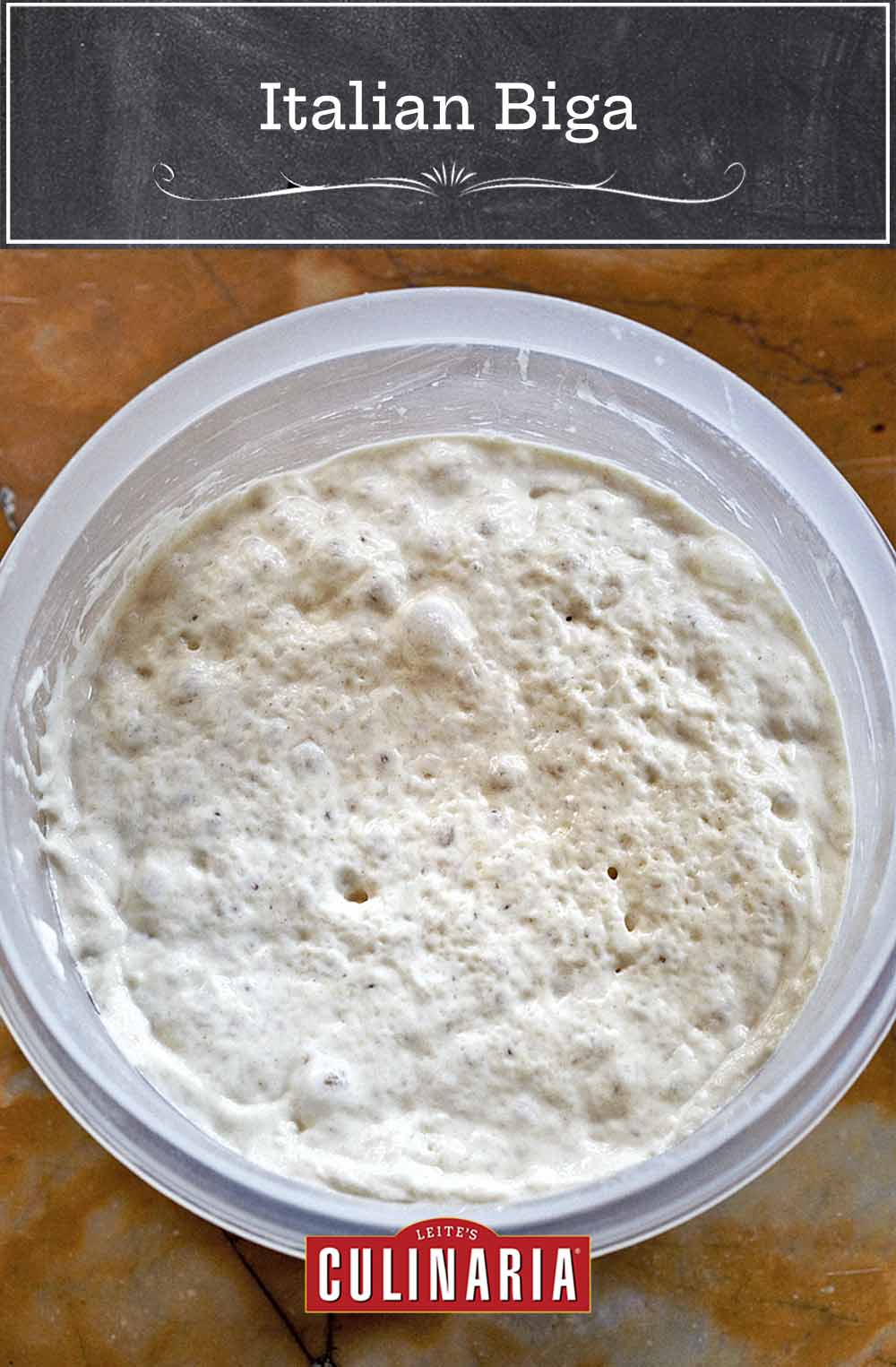
Many of the recipes for classic regional breads, such as this ciabatta recipe, begin with a starter dough made from small amounts of flour, water, and yeast allowed an initial fermentation. The starter, known as biga in Italy, or bighino when in small amounts, not only gives strength to what in Italy are weak flours, it also produces a secondary fermentation from which come the wonderful aroma, natural flavor, and special porosity of the final loaves and wheels of bread.
The important point about a biga is that the breads made with it develop a wonderful taste because their risings are long and bring out the flavor of the grain. Another benefit is that the loaves remain fresher and taste sweeter than those made with large amounts of commercial yeast.
In Italy, bakers use dough from the previous day’s baking to start a new dough. I keep some starter on hand at all times; by having it around, I can decide to make pane pugliese or ciabatta in the morning and have it for dinner that night. Because the first biga must come from somewhere, though, you may make it following the instructions below. It’s remarkable. It freezes very well and needs only about 3 hours at room temperature until it is bubbly and active again, or it can be refrigerated for up to 5 days.–Carol Field
LC Obliged to Biga Note
Behind each and every memorable bite of proper Italian bread we’ve daintily nibbled, hungrily inhaled, or otherwise somehow consumed, we have a biga to thank. So we’re feeling much obliged to Carol Field for this recipe. Nonna not included.

Italian Biga
Ingredients
- 1/4 teaspoon active dry yeast
- 1/4 cup warm water, 100°F to 110°F (38°C to 43°C)
- 3/4 cup plus 4 teaspoons bottled spring water, at room temperature (You can use tap water in a pinch.)
- 2 1/3 cups unbleached all-purpose flour
- vegetable oil, for the bowl
Instructions
- Stir the 1/4 teaspoon active dry yeast into the 1/4 cup warm water and let stand until creamy, about 10 minutes.
- Stir the 3/4 cup plus 4 teaspoons bottled spring water into the creamy yeast mixture, and then stir in the 2 1/3 cups unbleached all-purpose flour, 1 cup at a time. ☞ If mixing by hand, stir with a wooden spoon for 3 to 4 minutes. ☞ If mixing with a stand mixer, beat with the paddle at the lowest speed for 2 minutes. If mixing with a food processor, mix just until a sticky dough forms.
- Transfer the biga to a bowl lightly coated with vegetable oil, cover with plastic wrap, and let rise at cool room temperature for 6 to 24 hours, until the starter is triple its original volume but is still wet and sticky. (The bakers I admire most advise 10 to 11 hours for the first rise, but others are very happy with the 24 hours it takes for dough to truly become yesterday’s dough, and if you like sour bread, allow your biga to rest for 24 to 48 hours or even 72 hours.)
- Cover and refrigerate or freeze the biga until ready to use. (If refrigerating the biga, use within 5 days. If freezing the biga, let it rest at room temperature for about 3 hours until it is bubbly and active again.) When needed, scoop out the desired amount of biga for your recipe and proceed. I strongly recommend weighing the biga rather than measuring it by volume since it expands at room temperature. If measuring by volume, measure chilled biga; if measuring by weight, the biga may be chilled or at room temperature.

Nutrition
Nutrition information is automatically calculated, so should only be used as an approximation.
Recipe Testers’ Reviews
This is a perfectly suitable starting point for most any bread which uses a starter. I bake bread several times a week and it’s nice to have this handy. Sometimes I add this to a bread dough which doesn’t call for a starter just for the added flavor.












I am trying 2 different kinds of biga. I have read all day about ways to make ciabatta. The one from The Bread Baker’s Apprentice calls for making the biga, let double in size then deflate and put in refrigerator. I am letting yours set out at room temp for 24 hours. Will do the cook off tomorrow.
I did read that if you let it set out for over 8 hours you need to adjust the yeast as it will die.
You said it can set out for up to 72 hours?
Hi Jelly123, you can leave a biga out for 72 hours. The flavors will develop into that of a sourdough starter. Depending on a number of factors, (strain of yeast, how many are actually active, food source etc.) the yeast may begin to slow down as they run out of food. If you read the comments above, you will see instructions on feeding a starter. Hope this helps.
This started sounds incredible, I’m going to mix some up today to use for the ciabatta later this week! As someone new to the world of bread baking, I have somewhat of an elementary question; At what increments would I add more of this recipe to maintain a steady started in the fridge or freezer? And what would be the best way to do so for a starter of this nature?
Thanks so much!
Hi Julia, welcome to the world of baking! If you scroll through the comments below, one of our bread bakers, Larry Noak, gives some great advice on maintaining the biga as a starter.
Hi. I made this recipe today and followed the recipe exactly but it doesn’t have liquid consistency. Will it change form by tomorrow ?
Thanks
Hi Ami, did you weigh your ingredients? What type of flour did you use?